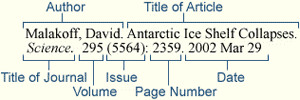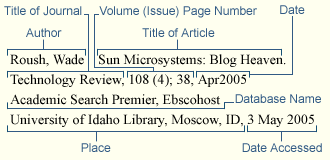Objectives:
If you are reading this Lecture #3, I hope you have already completed Quiz#3. There are no readings this week from the e-textbook. Your first draft of your annotated bibliography (due next week) requires you to find articles from the database OneSearch, which will be introduced to you shortly (see below). In addition, I have included the definition of "database" from, as you already know, my favorite dictionary, the Oxford English Dictionary.
This lecture will also introduce you to search strategies and techniques. Please pay close attention so that you may mimic these exercises [demonstrated] when you are ready to explore your own research topic in the assigned databases.
The lecture will end with a brief introduction to citations, which are a vital part of creating traditional bibliographies as well as annotated bibliographies. As you browse through the examples, please note the ones to be used for ARTICLES.
Any questions you may have, please do not hesitate to email me or drop by my virtual office hour.
Given the above definition of a database, know that you utilize databases all the time whenever you try to search for something. Here are a few examples you may utilize everyday not realizing it is a database:
| HULU or Netflix | an online streaming platform that provides a collection of on-demand online streaming videos |
| Amazon.com | an online marketplace that provides a collection of products for sale. As of 2021, known to be the world's largest online marketplace. |
| Zillow | an online real estate agency that provides a collection of homes for sale and apartments for rent in the United States |
| CheapOair.com | an online travel agency that provides a searchable collection of air-tickets, hotel reservations, and car rentals. |
Much like Hulu, Amazon.com, Zillow, and CheapOair.com, every Academic database contains a certain type or amount of information, a characteristic called "coverage." The "coverage" can typically be found in the database itself under links such as "About [name of database]," "Database information," "Title list," or "Sources," etc. Web-based databases are typically accessed from a link that is annotated with some information about coverage. Consider the following elements of an Academic Database:
| ELEMENTS | Examples in each element |
| What kinds of documents are in the database? |
journals, magazines, newspapers, books, book chapters, dissertations, audiofiles, videos, films, statistical tables, images, Web pages, software applications, etc...??? |
|
Which discipline does it cover? |
general (no specific discipline); engineering; business; medicine and allied health; social sciences (i.e., psychology, education, sociology, political science, etc.), science & technology, and so on... |
| What time period? | The current year? 2000-2015? 1850-1950? How often is the database updated? |
| What languages are included? |
English only? Spanish and English? Chinese? Arabic? Other languages? |
| Which publication types? | Scholarly? Popular? Trade? Government documents? Website? Videoclip? Others... |
| What is included in the record? |
A whole article or chapter (full-text) or just a brief description (abstract or bibliographic citation)? Publisher and title? Date? Page number(s)? Length of film/video? |
The CSI Library subscribes to over 200 databases for students and faculty to utilize for their scholarly endeavors. This LINK will take you directly to an A to Z list of databases available at the CSI Library. Most of these databases are linked into OneSearch, which is CUNY's portal to research materials and you will learn more about it in the module below this section. For the novice research, it is beneficial to use OneSearch. For the upperclassman or faculty member in a particular discipline, it will be most beneficial (and easier) to utilize a discipline-based database. Here are examples of discipline-based databases and topical databases:
| Discipline-Based | Topical |
| Education Source | Academic Video Online |
| Grove Music Online | Data.gov |
| MEDLINE Complete | EthnicNewswatch |
| MathSciNet | LGBTQ+ Source |
| PsycINFO | Opposing Viewpoint |
OneSearch is the portal to a collection of books, newspapers, journals, magazines, music scores, DVDs, and materials to the archives and special collections that are available at the CSI Library and in other libraries throughout the City University of New York. Think of OneSearch as the amazon.com to all information resources at your Library. OneSearch allows you to search across all the collections at the same time. Please click on this LINK, to learn from an interactive tutorial that will teach you how to utilize OneSearch to search for materials from the CSI Library. Take the quiz at the end of the tutorial. NOTE: When prompted for your email, please include your instructor's email (with a comma and no space), in order to be graded. Worth 25 points.

phrases | logical operators | truncation | wild cards | nesting
Most databases don't understand the natural language we speak and need help understanding what we're looking for. For this, they require a special set of conventions, including the following listed below. In your Blackboard Week #3 Folder, a video on "Tips for Effective Search Strategies" will further explain these. You can use these conventions in Google as well.
| CONVENTIONS | DESCRIPTIONS |
| Quotation marks | Around exact phrases (e.g. "college of staten island" will retrieve information about CSI and omit information about colleges or staten island). |
| Boolean operators |
Connecting words that narrow or broaden a search to include only what you need. Examples: AND, OR, NOT
|
|
Wild cards and truncation symbols (* # ? !) |
For terms that have variant forms of spellings or different possible endings. Examples: child* will retrieve child, children, childhood, childish, etc. technolog# will retrieve technology, technologies, and technological wom?n will retrieve woman and women gr!y will retrieve gray and grey |
| Nesting |
Placing terms in parenthesis to indicate separate units. It will look like an equation. ( (Internet and Children) NOT toddlers). This should yield information on all children above the age of toddlers. |
Using the topic of "Sex-Trafficking," the table below illustrates results from a search in Google and in OneSearch. Note how each search incorporates one or more of the conventions mentioned above to (i.e., quotation marks, Boolean, and nesting.) effectively narrow down the search results.
| Results from Google | Results from OneSearch | |
| Sex trafficking | 123,000,000 | 78,599 |
| "Sex trafficking" (quotation keeps the words together in the search) | 17,700,000 | 5,120 |
| "Sex trafficking" NOT "human trafficking" | 2,480,000 | 2,626 |
|
("Sex trafficking" NOT "human trafficking") AND prevention Nesting ( ) keeps separate units together |
1,360,000 | 157 |
| (("Sex trafficking" NOT "human trafficking") AND prevention AND "united states") | 470,000 | 88 |
| RESULTS | Includes: thousands of government reports, images, commercial and non-profit websites of organizations dealing with topic, statistics and data on the topic, books for sale on the topic; open access articles, citations to fee-based articles, and more. | Includes 1 newspaper articles, 8 books, 38 book chapters, 33 articles (of which 27 are peer-reviewed), 1 Dissertation, and more. |
| The results are ranked for you using an algorithm that anticipates the most popular and relevant information about the topic. This algorithm is influenced by number of times a webpage has been browsed through or searched for. You have to be knowledgeable about command searches to retrieve results specifically in chronological order, and other categories. |
Unlike Google results, databases allow you to manipulate data results by sorting the results by date (most recent or oldest), by relevance, author, source, etc. These library databases have sources that have been vetted as scholarly sources, so no need to look further.
|
Here are some tips if you find too much information, or too little information, or the wrong information in your search.
EXAMPLES of ways to narrow searches:
Too little Information
| EXAMPLES | |
| Very Narrow | Hillary Clinton AND media representation |
| Narrow | women candidates AND presidential campaigns |
| Broader | women AND politics |
| Very Broad | sexism AND politics |
You may avoid using the wrong information or wasting time doing research in the wrong database or website by doing the following:
A citation is a brief description of one specific information source, usually appearing in a bibliography, list of references, or a database. It includes enough information to permit the reader to find the source and may appear in a number of variant formats, e.g. American Psychological Association (APA), Modern Language Association (MLA), or Chicago Style.
A citation is made of parts, each part indicating specific information about the source. You can usually tell what type of source is being described by looking carefully at the citation. The citations below refers to an article found in a journal called the Journal of Social History:
MLA Style
Guy, Donna J. " The Women's Suffrage Movement in Argentina from Roca to Peron." Journal of Social History, vol 47, no.1, Fall 2013, pp. 238. EBSCOhost, doi:10.1093/jsh/sht015.
APA Style
Guy, Donna J. (2013). The women's suffrage movement in Argentina from Roca to Peron. Journal of Social History, 47(1): 238. EBSCOhost, doi:10.1093/jsh/sht015.
As you search databases for sources to support your research paper or annotated bibliography, you need to keep track of sources of interest that you anticipate using, i.e. books, reference resources, magazines, journals, Websites, etc. Why? Well, this information will later be used for a citation, which correctly presents (or introduces) the source of each annotation you write up. The table below provides at least one type of information you will need to write down with each of its important parts labeled for sources for the drafts of the annotated bibliography assignment. While the chart below follows the MLA style, you will learn more details about Citations in lesson 6 & 7:
| EXAMPLE SOURCE | EXAMPLE CITATION |
| Book: |  |
| Article in a periodical: |  |
| Sources on the web: |  |
| Online Article |  |
Click on the hyperlinked title to see how you can cite Images and Other Multimedia from MLA 8th edition.
---------------------------------------------------------------------------------------------------------------------------------------------------
Click on the following hyperlinked titles to see how to cite information from a Webpage from a News Website, Television, Video & Podcasts, and Social Media from APA 7th edition.
----------------------------------------------------------------------------------------------------------------------------------------------------
Please log in to BlackBoard to complete the following listed in Lesson#3 for Lessons for Week#3. Any assignment, quiz, or tutorial given in this lesson MUST be completed on or before February 20, 2024 and submitted by 11:30pm.
CREDIT: With permission, partial content on this web page was adapted from the University of Idaho Information Literacy Portal.

Facebook Twitter Instagram